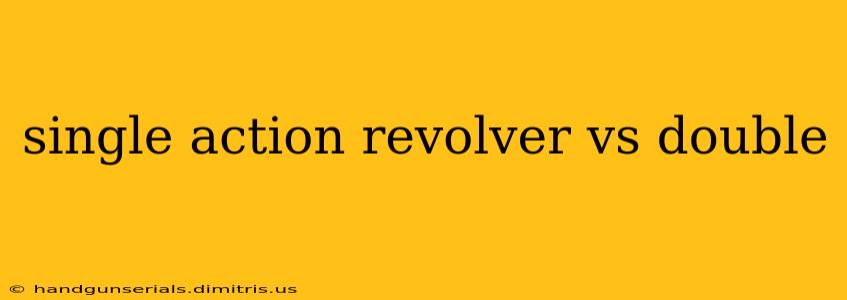Choosing between a single-action and a double-action revolver is a crucial decision for any firearm enthusiast, whether you're a seasoned shooter or a newcomer. This comprehensive guide will delve into the key differences between these two revolver mechanisms, highlighting their strengths and weaknesses to help you make an informed choice.
Understanding the Mechanics: Single-Action vs. Double-Action
The fundamental difference lies in how the hammer is cocked and the firearm is fired.
Single-Action Revolvers:
- Mechanism: In a single-action revolver, the hammer must be manually cocked before each shot. This action simultaneously rotates the cylinder and prepares the firearm for firing.
- Advantages: Single-action revolvers are often prized for their accuracy and crisp trigger pull. The long, deliberate cocking action allows for a smoother, more controlled shot. They're generally simpler mechanically, leading to greater reliability and easier maintenance.
- Disadvantages: The manual cocking process is slower, making single-action revolvers less suitable for rapid-fire situations. They also require more conscious effort and training to operate effectively.
Double-Action Revolvers:
- Mechanism: A double-action revolver allows for both cocking the hammer and firing the round with a single trigger pull. The first part of the trigger pull cocks the hammer, and the second part releases it, firing the round.
- Advantages: Double-action revolvers offer faster shooting capabilities, making them ideal for self-defense or situations requiring quick reaction times. They don't require manual cocking, streamlining the shooting process.
- Disadvantages: Double-action revolvers typically have a longer, heavier trigger pull, which can affect accuracy, especially for inexperienced shooters. The more complex mechanism can sometimes lead to slightly less reliability compared to single-action models.
Key Factors to Consider When Choosing
Several factors should influence your decision between a single-action and a double-action revolver:
1. Intended Use:
- Self-defense: Double-action revolvers generally excel in self-defense scenarios due to their speed and ability to fire quickly without manual cocking.
- Target shooting/competition: Single-action revolvers often offer a more accurate shot due to the lighter, crisper trigger pull, making them popular choices for target shooting.
- Hunting/plinking: Both single-action and double-action revolvers can be suitable for hunting and plinking, depending on your personal preference and shooting style.
2. Experience Level:
- Beginner: Double-action revolvers can be easier to learn on initially due to their simpler firing process. However, mastering the heavier trigger pull takes practice.
- Experienced shooter: Experienced shooters often prefer single-action revolvers for their accuracy and control, though they require more training.
3. Maintenance:
- Single-action: Generally simpler to maintain due to their less complex mechanism.
- Double-action: Might require slightly more specialized knowledge for maintenance and repair.
4. Budget:
Prices can vary greatly depending on the brand, model, caliber, and features of the revolver. Both single-action and double-action revolvers are available at various price points.
Conclusion: The Right Revolver for You
The choice between a single-action and a double-action revolver ultimately depends on your individual needs and preferences. Carefully consider your intended use, experience level, maintenance capabilities, and budget before making your decision. Understanding the mechanics and advantages of each type will ensure you select the revolver that best fits your shooting style and goals. Remember to always practice safe firearm handling and seek proper training before handling any firearm.

